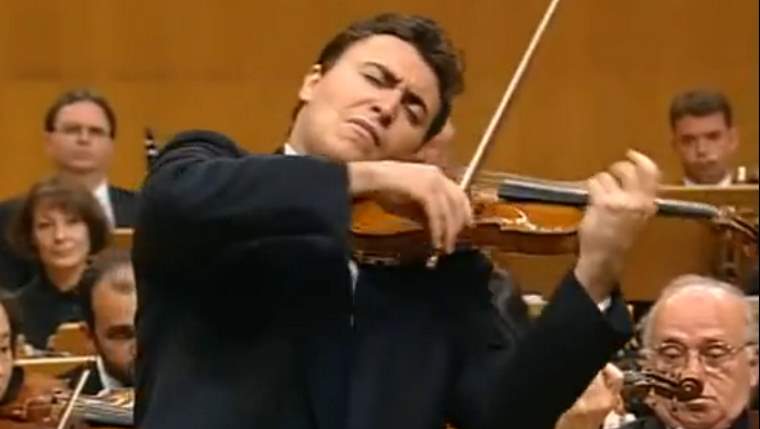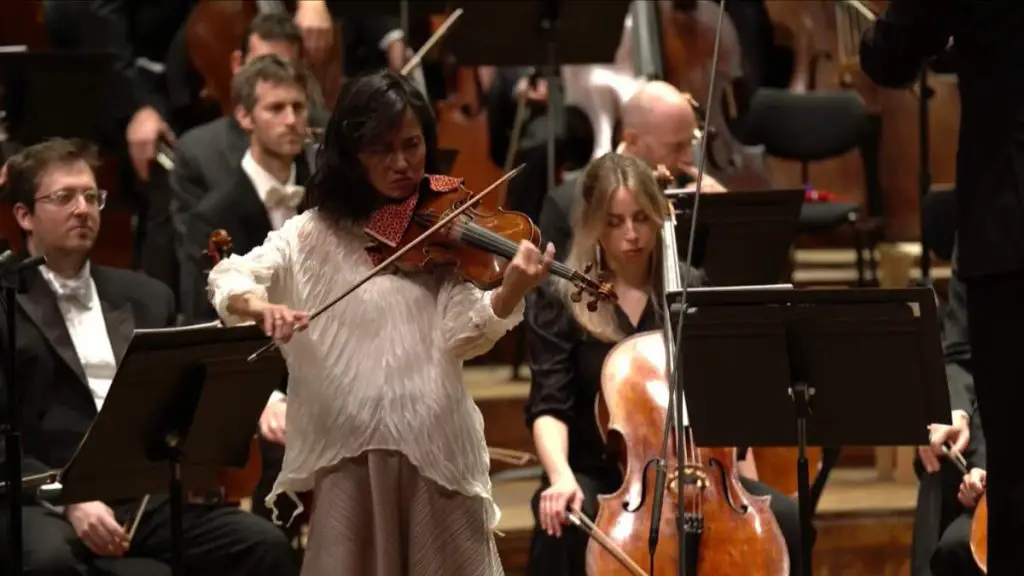Accompanied by the hr-Sinfonieorchester (Frankfurt Radio Symphony Orchestra), Julia Fischer performs Jean Sibelius’ Violin Concerto in D minor, Op. 47. Conductor: Alain Altinoglu. This performance was recorded on September 22, 2023, at the Alte Oper Frankfurt.
Jean Sibelius’ Violin Concerto
The Violin Concerto in D minor, Op. 47, by Jean Sibelius, is a highly esteemed work in the violin concerto repertoire and one of the most notable contributions of the Finnish composer to classical music. Composed in 1904 and revised in 1905, it stands as the only concerto Sibelius ever wrote and is celebrated for its deep expressiveness and technical demands.
Sibelius, primarily known for his symphonies, brought his unique sense of orchestral color and melodic invention to this concerto. It’s characterized by a profound connection with the Finnish landscape and culture, often evoking the vastness and mystery of the Nordic regions. The concerto is imbued with a sense of longing and introspection, qualities often associated with Sibelius’s music.
The concerto is demanding for the soloist, requiring not only technical mastery but also a deep interpretive understanding. It blends virtuosic passages with poignant, lyrical melodies, showcasing the violin’s emotional and expressive range. The orchestration, while rich, never overpowers the solo violin, instead providing a lush, atmospheric backdrop that complements the soloist’s performance.
Sibelius’s Violin Concerto has a special place in the hearts of violinists and audiences alike. It’s known for its unique blend of the virtuosic and the poetic, the emotional and the introspective. The piece reflects Sibelius’s personal struggles and his profound connection to the natural world, making it a deeply personal, yet universally resonant work.
Over the years, the concerto has been recorded and performed by many of the world’s leading violinists, each bringing their interpretation to its complex emotional landscape. Its enduring popularity is a testament to its place as a masterpiece of the violin concerto genre.
Movements
With start times in the video:
- Allegro moderato 00:00
- Adagio di molto 17:07
- Allegro ma non tanto 25:40
1. Allegro moderato
The first movement of Jean Sibelius’s Violin Concerto in D minor, Op. 47, is marked “Allegro moderato” and is known for its emotional depth and technical complexity. This movement beautifully sets the tone for the concerto, showcasing both the lyrical and virtuosic capabilities of the violin.
The movement opens with a soft, almost mysterious introduction by the orchestra, setting a somber and introspective mood. This is soon followed by the entry of the solo violin with a delicate yet expressive theme. The violin’s entrance is one of the most distinctive in the concerto repertoire, marked by a gentle, singing quality that immediately draws the listener into the concerto’s emotional world.
As the movement progresses, the music grows in intensity, featuring dramatic contrasts in dynamics and mood. The solo violin part is particularly challenging, with passages requiring great technical skill, including rapid scales, arpeggios, and double stops. These technical elements are not just showy displays of skill but are deeply integrated into the musical and emotional expression of the piece.
The interaction between the solo violin and the orchestra is another notable aspect of this movement. Sibelius, with his deep understanding of orchestration, creates a rich tapestry of sound that supports and interacts with the soloist. The orchestra’s role is not just accompaniment but an integral part of the musical conversation.
The first movement also features a cadenza, which is a solo section where the violinist has the opportunity to showcase their interpretive skills and technical prowess. In Sibelius’s concerto, the cadenza is a pivotal moment, allowing the soloist to explore the themes of the movement in a more introspective and free-form manner.
2. Adagio di molto
The second movement of Jean Sibelius’s Violin Concerto in D minor, Op. 47, marked “Adagio di molto,” is a stark contrast to the dynamic and technically challenging first movement. It stands out for its lyrical beauty, profound emotion, and the serene, almost meditative quality it brings to the concerto.
In this movement, Sibelius creates a world of deep introspection and poignant expression. The music is characterized by its lush, expansive melodies, which are both heart-rending and exquisitely beautiful. The solo violin leads with a tender, singing melody that is rich in emotional depth. This melody is one of the most memorable aspects of the concerto, showcasing the violin’s ability to convey deep emotion with subtlety and nuance.
The orchestration in the second movement is restrained yet evocative, providing a warm, supportive backdrop to the violin’s lyrical lines. Sibelius’s use of the orchestra here is masterful – never overpowering the soloist but rather enhancing the mood with delicate textures and colors.
As the movement progresses, there are moments of heightened emotion where the music swells, but it always returns to a state of gentle reflection. The interplay between the solo violin and the orchestra creates a dialogue that is both intimate and expansive, with each enhancing the other’s expression.
The Adagio di molto is often described as the emotional heart of the concerto. It provides a moment of calm and introspection between the more vigorous outer movements. The beauty and serenity of this movement often leave a lasting impression on listeners, offering a space for reflection and emotional connection.
3. Allegro moderato
The finale of Jean Sibelius’s Violin Concerto in D minor, Op. 47, marked “Allegro, ma non tanto,” is a return to the energetic and dynamic character that opens the concerto, bringing the work to a vigorous and thrilling conclusion.
This final movement is characterized by its rhythmic drive and lively tempo, offering a stark contrast to the serene and introspective second movement. It opens with an energetic orchestral introduction, setting a brisk and spirited tone. The solo violin quickly joins in, introducing a theme that is both agile and spirited, demanding a high level of technical proficiency and artistry from the performer.
Throughout the movement, Sibelius interweaves the solo violin with the orchestral texture in a playful and often challenging dialogue. The violin part is replete with rapid passages, intricate figurations, and a continuous demand for virtuosic playing. The movement showcases the violin’s capabilities in terms of agility, stamina, and expressiveness.
One of the most notable features of this movement is its rhythmic vitality. Sibelius employs driving rhythms that propel the music forward, creating a sense of excitement and urgency. This rhythmic energy is maintained throughout, even as the movement navigates through various themes and moods.
The orchestration in the third movement is robust and colorful, providing a rich backdrop to the solo violin. Sibelius’s skill in orchestration is evident in the way he balances the soloist against the full orchestra, ensuring that neither overwhelms the other.
The conclusion of the movement, and thereby the concerto, is marked by a return to the spirited energy of the beginning, culminating in a dramatic and exhilarating finale. This final section is a showcase of technical brilliance and emotional intensity, bringing the concerto to a triumphant and satisfying close.
Sources
- Violin Concerto (Sibelius) on Wikipedia
- Jean Sibelius’ Violin Concerto on Sibelius.info
- Violin Concerto, Op. 47 (Sibelius, Jean) on the International Music Score Library Project website



